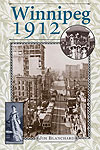13 November 2005
 No city on the continent was growing faster or was more aggressive than Winnipeg in 1912. No year in this city’s history epitomized energy and optimism more than 1912. As Canada’s most cosmopolitan and ethnically diverse centre, with 21 millionaires, with most of its population under the age of forty, Winnipeg was also the country’s liveliest (and third largest) city. Winnipeg was the centre of banking, the grain trade, and railroad operations.
No city on the continent was growing faster or was more aggressive than Winnipeg in 1912. No year in this city’s history epitomized energy and optimism more than 1912. As Canada’s most cosmopolitan and ethnically diverse centre, with 21 millionaires, with most of its population under the age of forty, Winnipeg was also the country’s liveliest (and third largest) city. Winnipeg was the centre of banking, the grain trade, and railroad operations.
But only one year later, the rumblings of the First World War ended the flow of investments and economic activity ground to a halt, sending the city into near bankruptcy and a recession that would last four decades.
In Winnipeg 1912, historian Jim Blanchard guides us through Winnipeg’s golden year. Beginning New Year’s Day at the Royal Alexandra, Blanchard takes us through backrooms and boardrooms, business deals and social events, right through to the following New Year’s Eve, giving us a surprising and illuminating look at our city. Winnipeg 1912 takes us on a visit to the Industrial Exhibition in July where Winnipeggers watched one of the first airplane flights over the city, the Horse Show where the city’s high society went to see and be seen, and two “lost neighbourhoods”: Roslyn Road and the Jewish district north of the Canadian Pacific Railway yards. You’ll meet the people, rich and poor, who made the city, for a time, a vibrant boom town.
Published by The University of Manitoba Press, Winnipeg 1912 is available for $24.95 at fine bookstores or order direct from UTP at 1-800-565-9523. ISBN 0-88755-684-1.